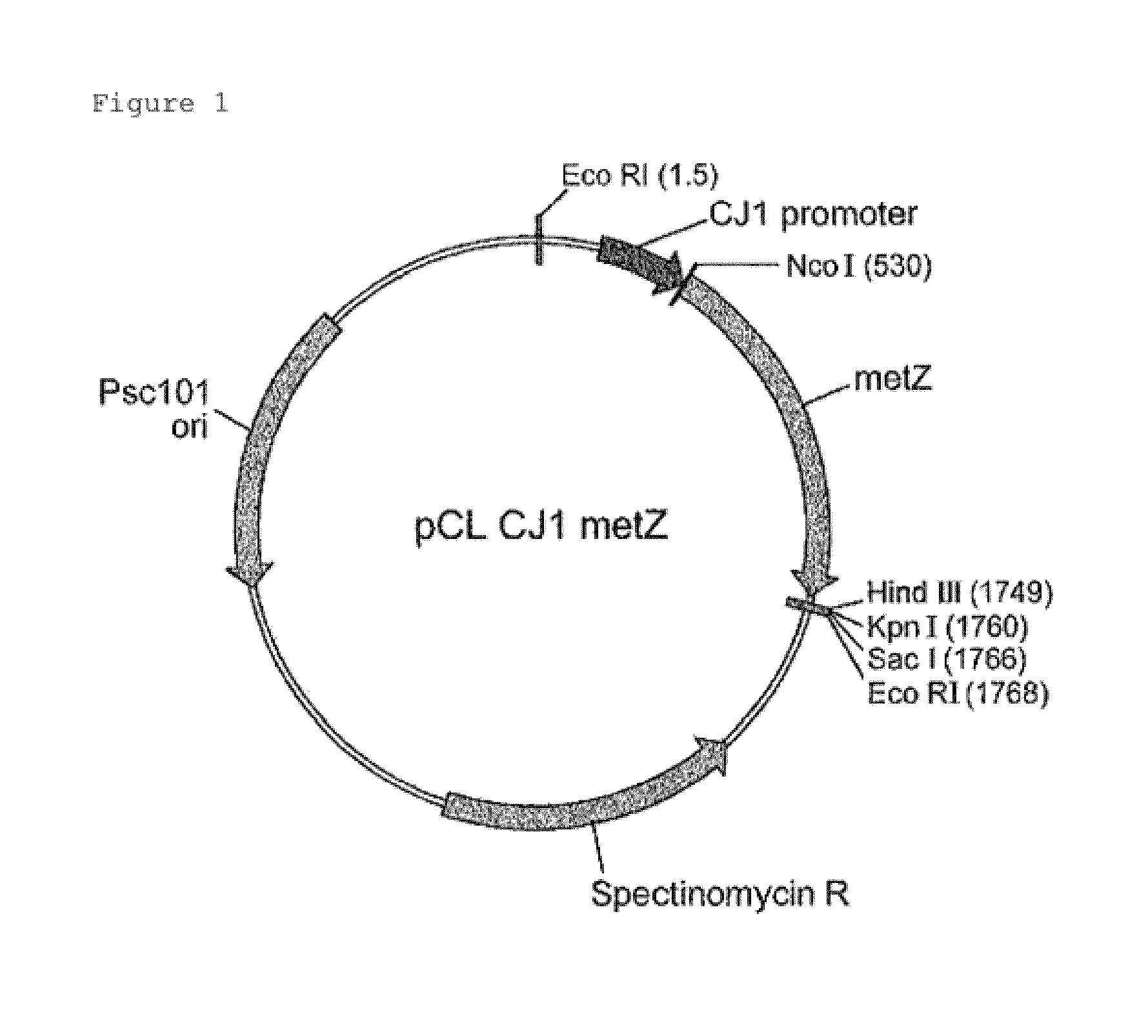O-acetylhomoserine sulfhydrylase or mutant protein thereof, and method for converting to methionine using the same
a technology of o-acetylhomoserine sulfhydrylase and acetic acid, which is applied in the directions of enzymology, organic chemistry, transferases, etc., can solve the problems of d-type and mixed l-type production disadvantages, and achieve the effects of reducing reaction time, reducing conversion rate, and producing l-methionine and acetic acid economically
- Summary
- Abstract
- Description
- Claims
- Application Information
AI Technical Summary
Benefits of technology
Problems solved by technology
Method used
Image
Examples
example 1
Production of Methionine Convertase
[0062]1-1. O-acetylhomoserine Sulfhydrylase from Hyphomonas Species
[0063]Primers were generated by obtaining the gene sequence of O-acetylhomoserine sulfhydrylase from Hyphomonas neptunium which converts O-acetylhomoserine to methionine from KEGG website (www.kegg.com). The chromosome of Hyphomonas neptunium was purchased from ATCC (USA). PCR reaction was performed with 30 cycles of denaturation step at 94° C. for 30 seconds, annealing step at 55° C. for 30 seconds, and extension step at 72° C. for 2 minutes, using the chromosome as a template and the primers of SEQ ID Nos. 1 and 2. HL PCR premix kit (Bioneer, Korea) was used for the PCR reaction.
[0064]DNA fragments obtained by the PCR reaction were cleaved by NcoI / HindIII and cloned into pCL-PCJ1 vector digested with the same enzymes. The finally prepared vector was named as pCL-PCJ1-MetZhne and the schematic diagram thereof was shown in FIG. 1. The cloned vectors were transformed into Escherichia...
example 2
Comparison of Convertase Expression Level, Substrate Specificity, ad Activity of Convertase
[0069]The expression level and enzymatic activity were compared between O-acetylhomoserine sulfhydrylase derived from Hyphomonas species and O-acetylhomoserine sulfhydrylase derived from Rhodobacter species by using each of the cell homogenates obtained by the methods of Examples 1-1 and 1-2.
[0070]In general, the amount of protein is quantified by using a protein quantification assay from BIO-Rad, as mentioned in Example 1-1, however, when analyzing the mixture of protein with E. coli proteins such as enzyme homogenate, it is difficult to compare the expression level of certain enzymes using the protein quantification method. Therefore, in this experiment SDS-PAGE was used to compare the expression level of the convertase in the cell homogenate obtained from Examples 1-1 and 1-2. As a result of comparing O-acetylhomoserine sulfhydrylase derived from Hyphomonas species (Metz-hne) and O-acetylho...
example 3
Comparison of the MetZ-hne and MetZ-rsp Reactions During Early Phase in a Medium of O-acetylhomoserine at High Concentration
[0075]In order to compare the conversion rates of MetZ-hne and MetZ-rsp enzymes in high concentration of O-acetylhomoserine, methionine conversion experiment was performed at O-acetylhomoserine concentration of 80 g / L. The relative methionine production rates were compared between O-acetylhomoserine sulfhydrylase derived from Hyphomonas neptunium and O-acetylhomoserine sulfhydrylase derived from Rhodobacter sphaeroides from the enzymatic conversion of 80 g / L O-acetylhomoserine in 1 ml tube scale over time. Reaction rates of O-acetylhomoserine sulfhydrylase can be compared by measuring the concentration of methionine produced from the reaction. More specifically, enzymatic conversion reaction was performed at 33° C. by adding 0.01 ml of sodium methyl mercaptan (15%, w / v) which is another substrate required for producing methionine, 0.01 ml of O-acetylhomoserine ...
PUM
| Property | Measurement | Unit |
|---|---|---|
| pH | aaaaa | aaaaa |
| pH | aaaaa | aaaaa |
| concentration | aaaaa | aaaaa |
Abstract
Description
Claims
Application Information
 Login to View More
Login to View More - R&D
- Intellectual Property
- Life Sciences
- Materials
- Tech Scout
- Unparalleled Data Quality
- Higher Quality Content
- 60% Fewer Hallucinations
Browse by: Latest US Patents, China's latest patents, Technical Efficacy Thesaurus, Application Domain, Technology Topic, Popular Technical Reports.
© 2025 PatSnap. All rights reserved.Legal|Privacy policy|Modern Slavery Act Transparency Statement|Sitemap|About US| Contact US: help@patsnap.com



